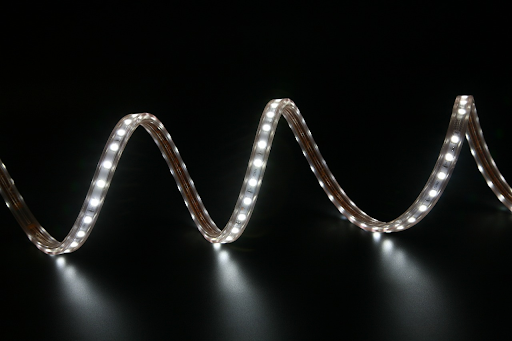If you ask yourself – “Can I bend and curve my LED strip lights?” – the answer is YES! But how to do it? Actually, there are a few possibilities. In this article, we tried to explain the methods of curving LED strip lights as precisely as possible. Enjoy reading!
What are LED strip lights?
LED strip lights are a really versatile and flexible form of lighting using eco-friendly and energy-efficient LED technology. You can find plenty of variants on the lighting market. However, all sorts of LED strips have similar characteristics.
First of all, they consist of numerous individual LED emitters that are mounted on a narrow and flexible circuit board. LED strips are also known for operating on low-voltage DC power. They are available in a broad range of brightness – they come in cool white, natural white or warm white. There are various colour options available.
LED lights can be run in longer lengths, and they don’t experience any loss in light output. There are neon flex LED strip lights available in various lighting stores. They come in different sizes and different types of voltage. LED strip lights have everything you would want from lights.
LED tapes – lights that can easily be manipulated to curve and bend
LED strip lights are lights which usually come with a form that is flat and rectilinear. Using them in rounded or curved shapes is impossible if they’re not modified. Thankfully, LED strips are quite pliable, so they can easily be manipulated to curve and bend. They are designed to be flexible. They’re actually the most flexible of all LED lights.
Robust printed circuit boards can be bend up to 90 degrees
PCB (printed circuit boards) of LED strip lights are really robust – it’s possible to bend them up to ninety degrees. If you want to fit your LED lights to curved surfaces, twist them or even loop them back on themselves, you ought to curve them. Luckily, we know how to do it easily! But first, you need to consider that higher-power LED tapes are not as flexible as lower-power ones. This is because the LED modules on high-power tapes are placed together and they require wider printed circuit boards for more heat dispersal.
What are the methods of curving LED strip lights?
You can actually curve and bend LED strip lights in a few ways. You can bend your LED strip light laterally, which means creating a curve of light on a flat surface. To achieve it, you need to bend the tape across the edge of the printed circuit boards.
Bending LED strips laterally using clip-on connectors
Generally speaking, if your goal is bending your LED strip light laterally to an angle greater than forty-five degrees, you can just use connector clips on corners or soldered links on corners. You are free to bend your LED tapes laterally with the use of clip-on connectors. If you have to bend your LED strip light at an angle greater than forty-five degrees, it is not recommended to physically bend it.
A much better option is using clip-on connectors with a standard 150 mm cable. The only downside of this choice is that the length of the cable can’t be adjusted, and it will be necessary to hide any excess cable somewhere.
The interesting thing about connectors is that ordering strips with flexible strip connectors that are already fitted is possible and convenient, and it’s worth taking advantage of this option. If you decide to buy LED strips and connectors separately, you will have to cut and solder connectors in the right place and way.
Soldering LED strip lights
Sometimes soldering is the best option. What you need is a soldering iron with a temperature control feature, LED strips, solder, heat shrink tubing and wire cutters. At first, you ought to cut LED strip lights at the proper, previously designated cut points to avoid damage to the circuitry. Use caution to avoid damaging the strip.
Then, cut two pieces of wire (choose the desired length first). Strip a quarter inch of insulation from each of the wires (from their ends). After that, you need to twist those wires together to form a tight connection. Soldering is the last crucial step, which is all about heating the soldering iron for a couple of minutes, applying solder to the soldering iron’s tip, placing it on the twisted wire, applying solder to the wire and finally applying solder to the LED strip pads.
At the very end of the process you can cover and secure the soldered connection by cutting a piece of heat-shrink tuning, sliding the tubing over the previously soldered connection and heating the tubing with the use of a heat gun or lighter until it shrinks and covers the connection.
Be careful!
Whichever technique you choose, please remember that you have to be careful while working with LED strips because they are sensitive, and it’s not difficult to damage them. Don’t lead to mishandling or overheating your LED tape lights!
Attachment:
LED strip lights1.png
alt=”LED strip lights”
Summary
Curving LED strip lights is possible with the use of clip-on connectors – this is one of the most obvious and the most popular options. The second option is all about soldering LED strip lights. Remember that LED strip lights are designed to be flexible, and you can use them in various ways!







